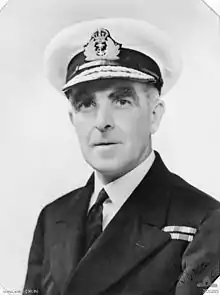John Gregory Crace
Vice Admiral Sir John Gregory Crace KBE, CB (6 February 1887 – 11 May 1968), also known as Jack Crace, was an Australian who came to prominence as an officer of the Royal Navy (RN). He commanded the Australian-United States Support Force, Task Force 44, at the Battle of the Coral Sea in 1942.
Sir John Gregory Crace | |
|---|---|
 Rear Admiral John Crace c.1940 | |
| Born | 6 February 1887 Gungahlin, Australia |
| Died | 11 May 1968 (aged 81) Hampshire, England |
| Allegiance | United Kingdom |
| Service/ | Royal Navy |
| Years of service | 1902–1946 |
| Rank | Vice Admiral |
| Commands held | Chatham Dockyard (1942–46) Task Force 44 (1942) HM Australian Fleet (1939–42) HMS Emerald (1934–37) HMS Osprey (1924–25, 1930–32) HMS Valhalla (1929–30) |
| Battles/wars | First World War Second World War |
| Awards | Knight Commander of the Order of the British Empire Companion of the Order of the Bath |
Early life
Crace was born to Kate Marion Crace and Edward Kendall Crace at Gungahlin, New South Wales (now part of the Australian Capital Territory). He was educated at The Kings School in Parramatta, before completing school in the UK in October 1899.
Naval career
Crace joined the Royal Navy as a cadet, aboard HMS Britannia, in May 1902. After being trained as a torpedo officer, Crace served in the battlecruiser HMAS Australia through much of the First World War.[1]
He travelled back and forth to Australia during the interwar years, and served in a series of sea and shore positions before being assigned command of the Australian Squadron in September 1939. Upon his arrival in Sydney, Crace grew increasingly dismayed at the state of the RAN fleet and attempted to resign.[2] However, after war with Japan broke out, Crace was appointed commander of the Allied Naval Squadron, ANZAC Force.
During the Battle of the Coral Sea, Crace narrowly escaped a Japanese air raid while patrolling south of New Guinea. He returned to Britain in June 1942 as a vice admiral, commanding the Chatham Dockyard. Crace was placed on the retired list in 1945, but remained in command at Chatham until July 1946.
He was appointed Knight Commander of the Order of the British Empire in 1947. He had been appointed Companion of the Order of the Bath in 1941.
Sir John Crace died in Hampshire, England in 1968. The suburb of Crace, Australian Capital Territory is named after Crace's father, Edward Kendall Crace.
References
Footnotes
- Dreadnought Project page on Crace.
- Action Stations Coral Sea, p.36
Bibliography
- Coulthard-Clark, Chris, Action Stations Coral Sea, Sydney: Allen & Unwin, 1991.
- Parrish, Thomas and S. L. A. Marshall, ed. The Simon and Schuster Encyclopedia of World War II, New York: Simon and Schuster, 1978.
- Keegan, John, ed. The Rand McNally Encyclopedia of World War II. New York: Rand McNally & Company, 1977.
Further reading
- Tucker, Spencer C., ed. Who's Who in Twentieth-Century Warfare. London: Routledge (UK), 2001. ISBN 0-415-23497-2
- Gillison, Douglas (1962). "Chapter 26 – Coral Sea and Midway". Volume I – Royal Australian Air Force, 1939–1942. Australia in the War of 1939–1945, Series 3: Air. Canberra: Australian War Memorial. Retrieved 13 April 2009.
External links
- Who's Who in Australian Military History: Vice Admiral John Gregory Crace, KBE
- Australian Dictionary of Biography: Crace, Sir John Gregory (Jack) (1887–1968)
- Liddell Heart Centre for Military Archives
- Royal Navy (RN) Officers 1939–1945: L.G.E. Crabbe to W.N. Custance
| Military offices | ||
|---|---|---|
| Preceded by Commodore Wilfrid Patterson |
Rear Admiral Commanding HM Australian Squadron 1939–1942 |
Succeeded by Rear Admiral Victor Crutchley |